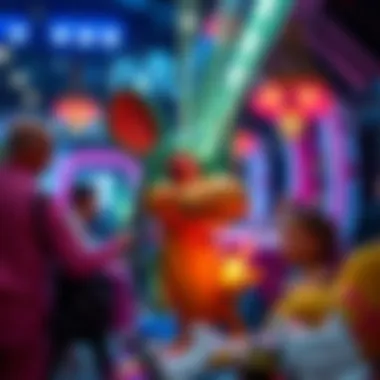Identifying Optimal NFT Investments for Smart Buyers


Intro
The world of non-fungible tokens (NFTs) has exploded in recent years, captivating investors, collectors, and the tech-savvy alike. While these digital assets may seem whimsical at first glance—often depicting pixelated cats or art masterpieces—the underlying technology and investment potential offer far more than meets the eye. Understanding this landscape is crucial not just for financial gain, but also for fostering a deeper appreciation of the innovation at play. Here, we’ll uncover the essential concepts, strategies, and tools to help you navigate the NFT market effectively.
Crypto Concepts Explained
As we wade into the ever-complex waters of NFTs, it’s vital to grasp the fundamentals that encapsulate this digital frontier. A good grounding in key terminology can illuminate the path forward.
Key Terminology and Definitions
NFTs stand out from regular cryptocurrencies due to their unique properties. Here are some terms to be familiar with:
- Non-Fungible Token (NFT): A digital asset that represents ownership or proof of authenticity of a unique item, secured via blockchain technology. Unlike cryptocurrencies, NFTs are not interchangeable on a one-to-one basis.
- Blockchain: A decentralized ledger that records transactions across multiple computers, ensuring that recorded transactions cannot be altered retroactively.
- Smart Contracts: Self-executing contracts with the terms of the agreement directly written into lines of code. These automate transactions and ensure that conditions are met before any exchange occurs.
Understanding these terms lays the foundation for exploring the investment strategies involving NFTs.
Practical Applications of Blockchain Technology
Blockchain is not just the backbone of NFTs; it opens up innovative possibilities that revolutionize traditional markets. Here’s a look at several applications that are reshaping industries:
- Art & Collectibles: Artists can tokenize their work, enabling fractional ownership and thus enhancing accessibility for buyers.
- Gaming: Players can own in-game assets as NFTs, which they can trade or sell on the open market.
- Virtual Real Estate: Platforms like Decentraland allow users to purchase virtual land with NFTs, generating new economic models.
By recognizing how blockchain serves these sectors, investors can identify potential growth areas within the NFT space.
Investment Strategies
Once you've carved out a solid understanding of the underlying technology, it’s time to explore the strategic avenues for investment.
Analyzing Market Trends and Indicators
Just like any asset class, NFTs exhibit market trends influenced by various factors such as public sentiment, tech adoption, and art movements. Keep an eye on:
- Market Volume: The total amount of NFTs sold can indicate a healthy ecosystem.
- Active Wallets: The number of wallets participating can give insights into user engagement.
- Collector Sentiment: Platforms like Twitter and Reddit can reflect the mood of the collectors, shedding light on potential up-and-coming projects.
Risk Management Techniques
Investing in NFTs comes with its own set of risks and rewards. To mitigate risk:
- Diversify your portfolio: Don’t put all your eggs in one basket; explore different niches within the NFT market.
- Conduct thorough research: Before making a purchase, investigate the team behind the project, their market traction, and community response.
- Set a budget: Know when to walk away. Establish a limit on how much you are willing to invest in NFTs and stick to it.
"Invest in what you believe in, not just in what is popular."
This principle is especially valid in the NFT space, where speculative bubbles can inflate quickly.
In closing, diving into NFT investments requires both a grasp of fundamental concepts and strategic tactics. By understanding the market dynamics, identifying valuable projects, and ensuring that you manage your risks, you’ll be standing on solid ground as you navigate this captivating arena.
For further information on NFTs, check out sources like Wikipedia or explore discussions on Reddit.
With the right tools and insights, you'll be better positioned to make informed decisions and potentially thrive in the burgeoning landscape of digital assets.
Preamble to NFTs
The emergence of non-fungible tokens (NFTs) marks a pivotal chapter in the narrative of digital assets, presenting a novel approach that transcends traditional forms of ownership. Understanding NFTs is not merely an academic exercise; it serves as the groundwork for making astute investment decisions in a market characterized by rapid growth and transformation. By diving into the specifics of NFTs, one can appreciate not just their uniqueness in representation but also their implications on ownership and value, which becomes crucial when navigating the potential returns and risks associated with these investments.
NFTs provide distinct advantages. For instance, they offer artists and creators a direct avenue to monetize their work, thus allowing for a more democratized approach to ownership and profit-sharing. Investors stand to gain from participating in this landscape, fueled by trends that often see exponential value appreciation, akin to buying a piece of digital art that skyrockets in demand. However, key considerations must be taken into account, including market volatility, the authenticity of digital ownership, and the evolving legal frameworks surrounding these assets.
Viewing NFTs through multiple lenses—be it as an investor, a developer, or a collector—enriches the discourse and understanding of their multifaceted nature. This discussion will explore critical aspects that underpin NFTs, which are essential for recognizing optimal investments in this burgeoning domain.
Understanding Non-Fungibility
To grasp NFTs, one must first unpack the concept of non-fungibility itself. Unlike cryptocurrencies such as Bitcoin or Ethereum, which are fungible—meaning each unit is interchangeable and holds the same value—NFTs are singular and irreplaceable. Each NFT represents a unique item or piece of content, whether that be digital art, music, or virtual real estate. This intrinsic quality lends itself to a variety of applications, allowing digital items to be bought, sold, and traded much like physical goods.
Why does this matter for investors? The non-fungible aspect means that the value of each NFT is determined not only by the market demand but also by its uniqueness and scarcity. For example, an NFT of a well-known artwork or a limited-edition video clip can command a significantly higher price than mass-produced digital files. Understanding the underlying principles of non-fungibility can assist potential investors in discerning which NFTs might surge in value and thus merit investment.
Historical Context of Digital Ownership
The notion of digital ownership is not as modern as the NFT craze suggests. Digital assets have existed for years, but the evolution of blockchain technology has enabled a more robust framework for establishing and verifying ownership. Before NFTs, ownership of digital files occurred through licenses or subscriptions, often lacking the permanence and transferability that NFTs now offer.
The genesis of this transformation can be traced back to the development of Ethereum, which introduced smart contracts—self-executing contracts with the terms of agreement directly written into code. This innovation paved the way for the launch of the first NFTs around 2017, debunking the myth that digital items could not be truly owned. For instance, the famed Cryptokitties game allowed users to buy, breed, and trade virtual cats, demonstrating that digital assets could indeed have proprietorship akin to physical objects.
The journey of digital ownership reflects broader societal trends toward valuing digital assets that embody uniqueness and individuality. As more creators and businesses embrace NFTs, the implications for ownership, profit, and investment continue to evolve. Recognizing this historical context is indispensable for understanding the current NFT landscape and can guide investors towards making informed decisions.


Evolution of the NFT Market
The NFT market has transformed dramatically over the last few years, making it essential for investors, developers, and enthusiasts to understand its evolution. Understanding the significant shifts in this space helps investors identify not only potential opportunities but also risks inherent in this fast-paced, speculative environment. It highlights the growing pains and developments, which shape current trends and future trajectories.
Key Milestones in NFT Development
Several crucial milestones mark the journey of NFTs from a niche concept to a mainstream investment option. Key events offer insight into the ecosystem's maturation:
- Birth of Cryptokitties (2017): This game was perhaps one of the first to demonstrate the potential of NFTs, allowing players to breed and trade uniquely designed digital cats. It caught the attention of both enthusiasts and investors, shining a light on the capabilities of blockchain.
- Rise of Marketplaces (2018): Marketplaces like OpenSea and Rarible became available, providing robust platforms for buying, selling, and discovering NFTs across categories. This expansion brought greater liquidity to the market, making it easier for creators and collectors to interact.
- Art and Crypto Collectibles Boom (2019-2020): Digital artists began to embrace NFTs as a medium for their work. Platforms like Foundation and SuperRare gained traction, enabling artists to sell their digital art as unique assets. This period highlighted how digital ownership could redefine creativity and art distribution.
- Mainstream Recognition (2021): A turning point occurred when high-profile celebrities, athletes, and brands began releasing their NFTs. Beeple's digital artwork sold for an astounding $69 million at a Christie's auction in March 2021, kicking off a wave of media attention and speculation on NFT values.
- Integration with Traditional Industries (2022): Major companies and brands entered the NFT market, leading to partnerships aimed at creating unique digital experiences. This shift has provided credibility and visibility, drawing in new investors from outside the typical crypto circles.
These milestones not only mark the growth of NFTs but also indicate the changing perceptions surrounding digital ownership. By understanding these events, one can better grasp what drives current market dynamics and anticipate future shifts.
Market Growth and Trends
The NFT market's growth trajectory is nothing short of explosive, influenced by various trends, many of which are still unfolding:
- Increased Use Cases: Beyond art and collectibles, NFTs are finding applications in gaming (e.g., player assets), real estate (e.g., virtual land), and identification (e.g., verified credentials). This diversification of use cases often leads to greater interest from various sectors.
- Cross-chain Compatibility: The development of interoperable blockchain technology is reducing barriers for users. Investors can now access multiple NFT ecosystems without facing the challenges that previously plagued them.
- Environmental Concerns: As awareness grows about the environmental impact of blockchain, particularly proof-of-work systems, more projects are exploring alternative models. A rising number of marketplaces are turning to proof-of-stake systems and eco-friendly blockchains, paving the way for sustainable NFT interactions.
- Community-Driven Projects: Many successful NFT releases stem from engaged communities. Collaborations and partnerships within these grassroots movements drive sustained interest and loyalty, paving the way for lasting value.
- Speculation and Volatility: Along with growth comes volatility. Speculative buying can lead to abrupt market changes. Investors need to tread carefully, employing diligent research and awareness of market sentiment.
It's clear that the landscape is rapidly changing, with countless threads that investors can pull—and others they need to avoid. By staying informed about these convergences of growth and shifts in understanding, stakeholders can better navigate the sometimes tumultuous waters of the NFT market.
“Understanding the evolution of the NFT market is like having a map in uncharted territory—it helps investors avoid pitfalls and seize opportunities.”
Identifying Valuable NFTs
Identifying valuable NFTs is crucial in understanding how to navigate this dynamic and sometimes bewildering market. Recognizing what defines value in the realm of non-fungible tokens can mean the difference between a wise investment and a costly mistake. As NFTs continue to captivate investor interest and spark diverse projects, discerning which tokens hold lasting worth becomes ever more important. A clear perspective on art and collectibles, utility and community engagement, as well as rarity and scarcity factors profoundly influences potential returns on investment.
Art and Collectibles in NFTs
The art and collectibles landscape within NFTs encapsulates a vibrant sphere where creativity meets commerce. Artists now have a platform to showcase their works digitally, offering a new avenue for ownership. Art NFTs can range from stunning digital paintings to unique pieces of animated art, often accompanied by smart contracts that confirm ownership and authenticity. This hones in on the intrinsic value an artist's reputation can bring.
Investors should consider a few key aspects in this space:
- Artist's Reputation: Well-known artists can command higher prices. Emerging artists might offer potential for future value appreciation.
- Historical Significance: Pieces that hold a pivotal position in digital art culture can significantly ramp up in worth.
- Community Support: Engagement from fans and collectors can boost an NFT's prominence and market value.
Here, the balance between aesthetic appreciation and financial return becomes crucial for investors.
Utility and Community Engagement
An NFT isn’t just a static image or a collectible item; many have inherent utility. The practical application of NFTs—such as access to exclusive events, digital experiences, or membership in a community—can significantly elevate their market value. This is often where the community becomes a driving force.
When assessing an NFT’s value, it is essential to evaluate:
- Functional Benefits: Does the NFT grant owners any tangible advantages?
- Community Involvement: A strong, passionate community can create a support system fostering continued interest and value.
Investing in NFTs connected to well-defined utilities can provide benefits that go beyond mere ownership, adding layers of value down the road.
Rarity and Scarcity Factors
In investing, scarcity often equates to value. NFTs that are rare or limited in availability typically draw more attention from collectors and investors alike. Understanding the principles of rarity and how they apply to NFTs is crucial. A higher degree of scarcity generally leads to heightened demand, which can drive prices up significantly over time.
To gauge the impact of rarity on an NFT’s value, consider the following:
- Edition Sizes: Are the NFTs one of a kind or part of a limited series?
- Burn Rates: Some projects allow owners to 'burn' their items, introducing scarcity into circulation.
- Underlying Technology: Unique traits in the smart contracts, blockchain networks, or the creation process can further influence an NFT’s perceived rarity.
By paying careful attention to these elements, investors can better navigate the NFT landscape and make more informed decisions about which tokens might stand the test of time.
"Rarity is not just about how many items are available; it’s also about the stories and communities built around them."
In summary, understanding the various facets that contribute to the value of NFTs can greatly aid in making sound investment choices. The interplay of art, community, utility, and rarity ensures a rich tapestry of opportunities awaits those who choose to engage with this innovative market.
Prominent NFT Projects
In the rapidly evolving world of non-fungible tokens, understanding the significance of prominent NFT projects is key for anyone looking to dive into this digital asset realm. These projects are not only indicative of market trends but also serve as a launchpad for innovation in the digital ownership space. They can offer investors a sense of reliability and community which is paramount when navigating uncharted waters.
Established NFT Marketplaces
Established NFT marketplaces have paved the way for widespread adoption of digital collectibles, providing a platform where creatives and collectors converge. These platforms, such as OpenSea and Rarible, are crucial since they allow artists to tokenize their works and reach global audiences without traditional gatekeeping.
- OpenSea stands as a titan in this domain, presenting a diverse array of NFTs ranging from art to virtual real estate. Its user-friendly interface encourages both novice and experienced collectors to engage actively.
- Rarible lives up to its name by offering a decentralized approach that empowers artists and collectors alike to trade freely. Its emphasis on community governance through the RARI token makes it distinct and appealing for long-term investors.
The rise of these marketplaces showcases the increasing demand for NFTs, which in turn contextualizes their significance. Keeping an eye on the evolving features of these platforms can provide insights into broader market trends and shifts.
High-Profile NFT Releases


High-profile NFT releases are like the splashy billboards that draw attention in the vast cityscape of cryptocurrency. These releases often generate buzz and can signal high-value investments for the astute collector. Think of works such as Beeple's "Everydays: The First 5000 Days," which sold for a staggering $69 million. This marked a tipping point in the public’s perception of digital art as a legitimate investment.
Investors should analyze the marketing strategies, community reception, and the artist’s reputation behind upcoming high-profile NFT releases. Successful releases often include a backstory that resonates with potential buyers, thus not merely presenting ownership but weaving a narrative that adds intrinsic value.
Upcoming Projects to Watch
Looking ahead, spotting upcoming projects that are creating a buzz can lead to profitable adventures. It’s essential to decipher which projects might become the next big thing in the NFT scene before they explode in popularity. Following trends on platforms like Twitter, Discord, and specialized subreddits offers a window into the grassroots enthusiasm surrounding new projects.
For instance:
- World of Women has sparked interest due to its focus on representation in the NFT space, and community social impact.
- Loot (for Adventurers), while initially a simple idea of providing usable item bags, has grown into an expansive universe, promoting community-generated content that challenges the conventional notions of gaming in the NFT landscape.
As the NFT landscape continues to mature, understanding the nuances of these key projects can empower investors to make informed decisions, facilitating better allocation of resources. The enthusiasm behind these earlier projects may give rise to valuable trends worth tracking.
"In the NFT space, vigilance and discernment are as crucial as capital. Always keep your ears to the ground and your eyes peeled for what’s coming next."
In summary, prominent NFT projects, spanning established marketplaces to upcoming initiatives, bear weight in optimizing investment strategies. Acknowledging their role is vital in navigating the labyrinth of non-fungible tokens and discerning potential opportunities amid the noise.
Investment Strategies in NFTs
Considering the rapid expansion of the NFT market, developing solid investment strategies is critical for anyone looking to navigate this complex landscape. Traditional investment principles, though valuable, may need some adaptation when applied to NFTs due to their unique characteristics and the emerging nature of the market. This section aims to sharpen your understanding of effective investment strategies tailored for NFTs by dissecting various approaches such as long-term versus short-term investments, the importance of diversifying your NFT portfolio, and thorough research into the values of NFTs.
Long-term vs. Short-term Investment
Approaching NFT investments can take different paths, and each path offers its advantages.
Long-term investments often revolve around holding NFTs with the belief that their value will appreciate over time. Collectibles like CryptoPunks and Bored Ape Yacht Club are classic examples. Investors in this space look for exceptional pieces, believing that with time, their scarcity will drive up value. Holding onto such assets during market fluctuations can be a daunting task, yet those patient enough might reap the rewards in the long run.
Conversely, short-term investments tend to focus on flipping NFTs—purchasing at a lower price and selling quickly at a higher price. This approach hinges on market trends and requires a sharper eye on timing. While the potential for profit is compelling, it comes with risks. As the saying goes, "the early bird gets the worm, but the second mouse gets the cheese." Not every investment will lead to gains, and without diligent tracking of market movements, one might easily fall into losses.
Adopting a balanced perspective on these strategies, investors might consider a hybrid approach, employing both long-term holding and short-term flipping to optimize returns.
Diversity in NFT Portfolios
Having a rich palette in your investment mix can guard against unforeseen market shifts. Just as no one should put all their eggs in one basket, diversifying your NFT portfolio can significantly mitigate risks. This diversification could span different categories—including art, music, virtual real estate, and exclusive memberships in digital communities. Each sector can exhibit distinct price behaviors, collecting various NFTs aimed at different audiences greatly enhances your potential for gains.
To elaborate, consider investing in:
- Established digital artworks from renowned creators
- Upcoming projects that show promise due to community engagement
- Utility-driven NFTs associated with online games or platforms
- Digital fashion items linked to virtual events and metaverse spaces.
Also, allocating small investments across several categories allows you to identify trends and performances without exposing yourself to significant risk. An informed investor keeps up with news and developments across categories, enabling smarter, data-driven decisions.
Researching NFT Values
In a realm as volatile as the NFT market, diligent research stands out as a pivotal strategy. Simply relying on instinct or hearsay may lead to regretful decisions. To effectively gauge the value of NFTs, several factors should be scrutinized.
Market trends: Keeping an eye on sales history and recent auction prices can help gauge whether a particular NFT is over or under-priced. Tools like OpenSea or Rarible provide valuable insights into historical prices.
Rarity and scarcity: Understanding the uniqueness of the NFT, whether it’s an edition of 1 or 10, can influence its desirability.
Creator reputation: The background of the artist or developer behind the NFT often plays a significant role. Well-established creatives typically command higher prices, often based on their previous works.
Community engagement: An NFT that fosters an active community often boasts a stronger market presence. The vibrancy of the community can be a strong indicator of future value as followers and supporters rally to promote and buy into the project.
Through thorough research, investors can arm themselves with knowledge, making informed buying or selling decisions that align with their financial goals.
"In the world of investments, knowledge is your best ally, particularly in an evolving landscape like NFTs."
By employing well-thought-out strategies tailored to the NFT market, investors can navigate the unpredictable waters with a clearer vision and improved confidence.
Risks Associated with NFT Investments
Investing in non-fungible tokens (NFTs) can be exhilarating and holds immense promise. Yet, it’s essential to recognize the substantial risks lurking beneath the surface. These risks can significantly impact the value of NFT holdings and, ultimately, the investment outcome. Investors, analysts, developers, and enthusiasts alike must familiarize themselves with these uncertainties to make informed decisions and tailor their strategies accordingly. Ignoring these potential pitfalls could lead to adverse consequences in a landscape that is anything but stable.
Market Volatility
The NFT market is notoriously prone to fluctuations. Prices can soar rapidly one minute and plummet dramatically the next. This volatility is spurred by various elements, including market sentiment, speculative behavior, and the ever-changing trends in digital art and collectibles. An investor might purchase an NFT at a high price, only to find it depreciating when the fervor dies away. Understanding the market cycles is crucial for any investor wanting to safeguard their investments.
- Key Factors Contributing to Market Volatility:
- Rapid changes in investor sentiment.
- Seasonal trends affecting demand, such as certain events or releases.
- Hype surrounding new projects or artists.
- External influences, like regulatory news or market reports.


"The NFT market is like a rollercoaster ride; you must hold on tight and brace for the ups and downs."
Fraud and Scams in the NFT Space
The anonymity often associated with cryptocurrency transactions can sometimes be a double-edged sword. While it protects users, it also opens the door for fraudulent activities. Scammers exploit unsuspecting investors through fake marketplaces, counterfeit NFTs, and phishing schemes intending to steal personal information or funds. Such occurrences not only cause financial loss but can also tarnish the reputation of genuine projects and the NFT ecosystem as a whole.
- Common Types of NFT Scams:
- Phishing scams: Attackers lure victims with fake websites mimicking legitimate marketplaces.
- Fake listings: Fraudsters create convincing replicas of popular NFTs to sell.
- Pump and dump schemes: Groups artificially inflate an NFT’s value through coordinated buying, only to sell off their assets at the peak.
Staying informed and cautious is paramount when navigating these waters to ensure investments are not easily compromised.
Technological Risks Linked to Smart Contracts
Smart contracts form the backbone of NFT transactions; they automate the process but also introduce risks. Issues can arise from coding errors, vulnerabilities in the contract, or the overarching infrastructure used by NFTs. Flaws in smart contracts may enable exploitation, resulting in significant losses for investors. Moreover, if a platform's underlying technology fails or becomes obsolete, it can destabilize the tokens minted on it.
- Considerations Regarding Technological Risks:
- Smart contract audits: Ensure NFTs are deployed using rigorously tested contracts.
- Platform stability: Research the blockchain on which NFTs reside for performance metrics and user trust.
- Maturity of technology: Newly developed platforms may have limitations causing unpredicted issues.
By understanding these technological vulnerabilities, investors can better assess the safety of their NFT assets and choose reputable projects that prioritize security and transparency.
By bearing in mind the risks intertwined with NFT investments, investors can position themselves to navigate this complex environment more effectively, making choices that lead to smarter financial outcomes.
Future Trends in NFTs
The NFT landscape is continually evolving and, as with any investment, understanding future trends is crucial. The potential for growth in this space is as vast as it is uncertain. Investors and enthusiasts should stay abreast of emerging technologies, regulatory frameworks, and user experience enhancements that influence market dynamics. By recognizing these shifts, one can make informed decisions about which NFTs to invest in while avoiding pitfalls that may arise from market volatility or outdated assumptions.
The Role of Virtual Reality and Metaverse
Virtual reality (VR) and the metaverse are no longer just whimsical concepts but are becoming realities that are shaping the future of digital assets. As platforms like Decentraland and The Sandbox gain traction, they introduce opportunities where NFTs function not merely as collectables but as integral assets that enhance user experiences.
Investing in NFTs that offer functionality in these virtual worlds can provide substantial returns. For instance, digital real estate is becoming hot property, where land owners can create experiences, host events, or lease their plots. The unique aspect here is the blend of tangible investment in virtual environments and the potential for interactive digital wealth. Keep in mind:
- Engagement is key: Proactive participants of the metaverse often gain insights into favorable trends before they become mainstream.
- Strategic positions: Acquiring virtual land in high-traffic areas could yield significant profits if the platform expands or gains popularity.
Impact of Regulation on NFT Markets
The regulatory environment surrounding NFTs remains a gray area. As governments grapple with classifying these assets, the landscape could shift dramatically based on new laws or guidance. This uncertainty presents both risk and opportunity for investors.
Here are some considerations:
- Tax Implications: Understanding how NFTs will be taxed is essential. Some jurisdictions may treat them as capital assets, leading to varying tax obligations upon selling.
- Compliance: Investors should be aware of the need for compliance with anti-money laundering regulations. This could affect transactions and project launches.
The way regulations shape the NFT market can either bolster confidence or induce fear. Staying informed about potential changes is essential for sound investment decisions.
Evolution of User Experience in NFT Platforms
User experience (UX) is a fundamental aspect that influences the adoption of NFTs. Platforms that offer streamlined, intuitive interfaces will likely attract a larger audience. The evolution of UX in NFT marketplaces could manifest through tailored browsing experiences, advanced filtering tools, and enhanced community features.
As investors, consider the following:
- Accessibility: How user-friendly is the platform? A platform that prioritizes end-user experience, especially for newcomers, can accelerate market growth.
- Community Engagement: The more interactive a platform is—with discussion forums or social features—the more likely users will feel invested in their NFTs and the platform.
Investing in projects that recognize the importance of UX can potentially yield higher returns, as their user base expands alongside better features.
Understanding these future trends, from the immersive realms of the metaverse to navigating the murky waters of regulations and user experiences, will enable investors, analysts, and developers to identify optimal NFT investments with greater clarity.
Concluding Thoughts
As we draw our conclusions, it is paramount to emphasize that navigating the complex world of NFTs requires thoughtful consideration and ongoing research. The landscape is not just about collecting digital art or tokens; it's about understanding the deeper implications of what these assets represent in ownership and scarcity in the digital age.
Reflecting on the NFT Landscape
The NFT market has seen unprecedented growth, establishing a unique place in both digital culture and finance. Artists and collectors alike have discovered new avenues for expression and investment. Yet, it's essential to remember that not every NFT holds the same value. Factors such as creator reputation, community engagement, and historical significance weigh heavily when assessing potential purchases. Artworks from established names like Beeple or collections such as Bored Ape Yacht Club exemplify successes, driven largely by brand recognition and community loyalty.
Furthermore, the NFT space is continuously evolving. Trends emerge and disappear like the changing seasons. Keeping an eye on market movements—be it through platforms like OpenSea or Rarible—helps investors stay informed.
"Investing in NFTs is very much like investing in art; you have to trust your instincts, but also your research."
Making Informed Investment Decisions
Informed decision-making stands at the core of successful NFT investment strategies. To maximize potential gains, one must digest a multitude of data points: market trends, social media sentiment, project transparency, and even historical resale values. This diligence helps form a robust investment thesis rather than purely relying on hype or social media buzz.
When considering an NFT, look for:
- Verified authenticity: Ensure the asset exists on a reliable blockchain with clear ownership provenance.
- Community support: Strong communities often elevate the value of NFTs; check forums on Reddit or follow discussions on Twitter.
- Utility features: Certain NFTs offer practical benefits, such as access to exclusive events or services, enhancing their overall worth.
Balancing these factors allows investors to make choices grounded in research and not just emotional reactions. Taking the time to reflect deeply on the NFT landscape and focusing on informed decision-making can lead to more favorable outcomes in an otherwise unpredictable market.















